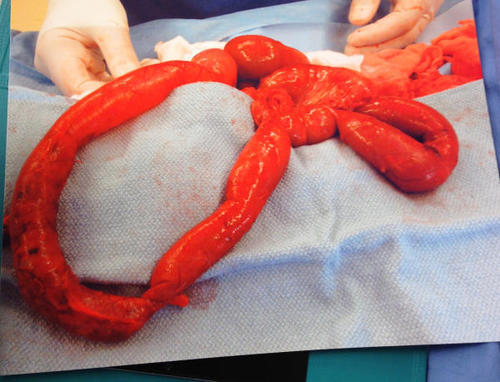This short YouTube video shows a day in the ED at the largest and busiest hospital in the world. The hospital is located in South Africa and is massive, with nearly 3000 beds and covering 173 acres. Over 2,000 patients per day are seen at the hospital, and a large number are trauma victims.
Category Archives: General
What The Heck? Pediatric Abdomen: The Answer
By now, you know the story. Sick little girl who comes to your ED with a rigid abdomen. She’s been previously healthy, and there is no history of trauma.
Here’s the surgical specimen again:

This is a loop of small bowel. It it very inflamed, and you can see a darker color on the portion that is at the left of the picture. This is an area of necrosis, indicating that this portion lost its blood supply some time ago, possibly even a day or two.
A number of readers guessed volvulus or internal hernia, which are on the usual list of differential diagnoses.
But hey, this is the Trauma Professional’s Blog!
Look again carefully at that loop of bowel on the left. There is no mesentery attached to it! This is a classic buckethandle injury. And the only way to get it is from blunt force, typically a car crash. There were also low grade lacerations of the liver and spleen.
What’s the diagnosis now? Non-accidental trauma!
On closer questioning, the father’s story began to change when confronted with this information. As the child recovered from surgery, she underwent a workup and was found to have a number of healed and healing rib fractures of various ages. Child protective services was involved, and the father ultimately admitted to repeatedly striking her in the abdomen in a fit of rage.
Bottom line: Healthy children who are abruptly found to be very ill (or in cardiac arrest) have a high likelihood of non-accidental trauma in addition to the usual medical and surgical culprits. Never lose sight of that, and always maintain some suspicion, no matter how nice the parents seem to be. Treat the child, but always be cognizant of their social/domestic situation!
What The Heck? Pediatric Abdomen Part 2
Yesterday, a child was brought to your ED who looked bad and felt bad, to the point you are convinced she has peritonitis. If the abdominal exam is convincing enough, there is no need for diagnostic imaging It would only serve to add time and radiation to the equation.
If you had really insisted on getting something like a CT, I would have told you that it just showed nonspecific distension and a small amount of free fluid. Helpful, right? And that at the age of 34 she would develop lymphoma for no apparent reason.
Your surgery team takes this patient immediately to the OR and finds this:

So now my questions are:
- What is going on here? What is this?
- What is really going on here? What’s the problem?
Please Tweet and leave emails or comments with your guesses. Discussion and answers tomorrow!
What The Heck? Pediatric Abdomen
Here’s an interesting case for you to think about. A three year old female is brought to your ED with a three day history of abdominal pain which has been getting worse. She started vomiting yesterday, and hasn’t wanted to eat for two days. The child has been completely healthy until now. The parents deny any history of trauma.

On exam, the child appears to be ill. She has a distended abdomen bordering on rigidity, and is markedly tender. A FAST exam is performed, which shows a small amount of fluid only in the pelvis.
Here are my questions for you:
- What tests would you like to order?
- What is going on here?
Remember, this is the Trauma Professional’s Blog, after all!
Nursing Tips for Managing Pediatric Orthopedic Trauma
Nurses have a complementary role with physicians in caring for children with orthopedic injuries. Typically, the child will have been evaluated and had some sort of fracture management implemented. In children, nursing management is easer than in adults since a child is less likely to need an invasive surgical procedure. Many fractures can be dealt with using casts and splints alone.
Here are a few tips for providing the best care for your pediatric patients:
- Ensure adequate splinting / casting. You will have an opportunity to see the child at their usual level of activity. If it appears likely that their activity may defeat the purpose of the cast or splint, inform the surgeon or extender so they can apply a better one.
- Focus on pain control. Nothing aggravates parents more than seeing their child in pain! Make sure acetominophen or ibuprofen is available prn if pain is very mild, or scheduled if more significant. Ensure that mild narcotics are available if pain levels are higher. Remember, stool softeners are mandatory if narcotics are given.
- Monitor compartments frequently. If a cast is used, check the distal part of the extremity for pain, unwillingness to move, numbness or swelling. If any are present, call the physician or extender and expect prompt attention to the problem.
- Always think about the possibility of abuse. Fractures are rarely seen in children under 3, and almost never if less than 1 year old. If you have concerns about the physical findings or parent interactions, let the physician and social workers know immediately.


